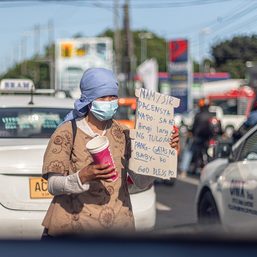SUMMARY
This is AI generated summarization, which may have errors. For context, always refer to the full article.

CAGAYAN DE ORO, Philippines – The gross regional domestic product of Northern Mindanao grew by 7.2% in 2022, indicating recovery from the economic slump caused by the COVID-19 pandemic. However, residents of the region have yet to feel this improvement, according to an official from the state’s planning agency.
“Poverty remains the biggest challenge,” said Mylah Faye Aurora Cariño of the National Economic and Development Authority (NEDA) in Northern Mindanao during the June 21 launch of the Northern Mindanao Regional Development Plan (NMRDP) for 2023-2028.
Cariño said Northern Mindanao had previously reduced poverty levels by 15 percentage points, and the six-year NMRDP aims to further reduce the poverty incidence among the population from 26.2% in 2021 to 15% by the end of 2028, and among families by 10%.
The 21-chapter NMRDP, developed through a series of consultations and focused group discussions among various stakeholders in the region, includes a list of 2,045 identified projects starting this year until 2028.
She said these projects aim to stimulate economic activities, create jobs, and provide sources of livelihood, requiring over P3 trillion in public and private investments during the six years.

“The 2022 data is still incomplete until now, hence we used the 2021 figures,” said Cariño, who also serves as the vice-chairperson of the Regional Development Council (RDC) in Northern Mindanao.
Lanao del Norte Governor Imelda Dimaporo, the chairperson of the RDC, said the completion of the Panguil Bay Bridge project, connecting her province to Tangub City, Misamis Occidental, would facilitate the transport of goods, delivery of basic services, and movement of people.
Dimaporo said the development of Cagayan de Oro into a metropolis within the planning period would accelerate the region’s goal of becoming an international gateway in Mindanao by 2040.
The planned Metropolitan Cagayan de Oro aims to expand the region’s urban center to include 14 localities from the city’s nearby provinces.
The RDC-X aims to transform Northern Mindanao’s five provinces and nine cities into a “leading agricultural hub and major industrial, tourism, and trade center.”
NEDA Undersecretary Carlos Bernardo Abad Santos described the NMRDP as “meticulously crafted” and “aligned seamlessly” with the Philippine Development Plan for 2023 to 2028.
“This plan signifies not an end but rather the dawn of a crucial phase,” he told members of the development council.
He said strategies must be translated into tangible actions and continually evaluated, while also addressing challenges such as inflationary pressures, climate change, and the spread of animal diseases. The region, he noted, has already become a major producer of livestock and poultry products.
Abad Santos acknowledged the region’s recovery from negative economic growth during the pandemic, placing it just behind the National Capital Region and the Cordillera Autonomous Region.
Data from the Philippine Statistics Authority (PSA) showed that the region’s economy expanded by 7.2% last year, surpassing the 6.3% growth in 2021 and the 5.6% before the COVID-19 pandemic in 2019. This growth translated to an increase of P62.49 billion in the region’s gross domestic product.
The PSA-10 said a family of five requires an average of P11,920 per month to fulfill their basic food and non-food necessities in 2021, which corresponds to the poverty threshold in Northern Mindanao.
According to the report, the poverty incidence in the region was 26.2%, affecting approximately 1.72 million individuals that year.
During the first semester of 2021, Lanao del Norte showed the highest poverty incidence at 39.1%, affecting approximately 62,900 families. In contrast, Cagayan de Oro had the lowest poverty incidence of 11.6%, affecting around 22,600 families.
Although Bukidnon’s poverty incidence stood at 36.9%, it recorded the largest number of poor population and poor families in the region. The province had 115,000 families or 605,500 individuals living in poverty, showed the PSA-X report. – Rappler.com
Add a comment
How does this make you feel?

![[In This Economy] Part 2 | POGOnomics: Are we banning POGOs out of fear, outrage, not rational thought?](https://www.rappler.com/tachyon/2024/06/thought-leaders-pogonomics-part-2b.jpg?resize=257%2C257&crop=292px%2C0px%2C720px%2C720px)
![[In This Economy] POGOnomics: Weighing the costs and benefits of POGOs](https://www.rappler.com/tachyon/2024/06/thought-leaders-pogonomics-part-1.jpg?resize=257%2C257&crop=279px%2C0px%2C720px%2C720px)
![[In This Economy] Is the Philippine economy stable?](https://www.rappler.com/tachyon/2024/05/philippine-economy-stable-may-10-2024.jpg?resize=257%2C257&crop=461px%2C0px%2C1080px%2C1080px)






There are no comments yet. Add your comment to start the conversation.